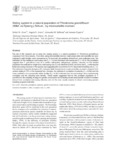Use este identificador para citar ou linkar para este item:
http://www.alice.cnptia.embrapa.br/alice/handle/doc/406930Registro completo de metadados
| Campo DC | Valor | Idioma |
|---|---|---|
| dc.contributor.author | ALVES, R. M. | pt_BR |
| dc.contributor.author | ARTERO, A. S. | pt_BR |
| dc.contributor.author | SEBBENN, A. M. | pt_BR |
| dc.contributor.author | FIGUEIRA, A. | pt_BR |
| dc.date.accessioned | 2011-04-10T11:11:11Z | pt_BR |
| dc.date.available | 2011-04-10T11:11:11Z | pt_BR |
| dc.date.created | 2005-06-24 | pt_BR |
| dc.date.issued | 2003 | pt_BR |
| dc.identifier.citation | Genetics and Molecular Biology, v. 26, n. 3, p. 373-379, 2003. | pt_BR |
| dc.identifier.uri | http://www.alice.cnptia.embrapa.br/alice/handle/doc/406930 | pt_BR |
| dc.description | The aim of this research was to study the mating system of a natural population of Theobroma grandiflorum (cupuassu) from Nova Ipixuna, Pará state, using microsatellite markers. Eight polymorphic microsatellite loci were analyzed in eight families, each represented by 10 six-month old seedlings derived from open-pollinated pods. The estimation for the multilocus outcrossing rate ($tm= 1.0) and individual outcrossing rate ($t= 1.0) for this population suggests that T. grandiflorum may be a perfect outbreeding (allogamous) species. Likewise, for the studied population the estimate for single locus outcrossing rate ($ts) was elevated (0.946), but lower than $tm, confirming the likely outcrossing character of the species and suggesting the occurrence of 5.4% biparental inbreeding rate ($tm-$ts). The estimation of genetic divergence ($FST) between allelic frequencies in ovules and pollen revealed a deviation from random mating in 75% of the evaluated loci. Likewise, the estimate of correlation of paternity ($rp= 0.930) and the mean coefficient of co-ancestrality within families ($?xy= 0.501) indicated that the outcrossings were predominantly correlated, and the offspring were full-sibs. These results suggested that for this particular population of T. grandiflorum, the sampling strategy for genetic conservation and breeding should adopt specific models for families derived from correlated outcrossing (full-sibs) and not the ones usually adopted in classic outcrossing species breeding programs (half-sibs). | pt_BR |
| dc.language.iso | eng | eng |
| dc.rights | openAccess | eng |
| dc.subject | População natural | pt_BR |
| dc.subject | Conservação de germoplasma | pt_BR |
| dc.subject | Nova Ipixuna | pt_BR |
| dc.subject | Pará | pt_BR |
| dc.subject | Brasil | pt_BR |
| dc.title | Mating system in a natural population of Theobroma grandiflorum (Willd. ex Spreng.) Schum., by microsatellite markers. | pt_BR |
| dc.type | Artigo de periódico | pt_BR |
| dc.date.updated | 2016-11-29T11:11:11Z | pt_BR |
| dc.subject.thesagro | Cupuaçu | pt_BR |
| dc.subject.thesagro | Genética | pt_BR |
| dc.subject.nalthesaurus | Amazonia | pt_BR |
| riaa.ainfo.id | 406930 | pt_BR |
| riaa.ainfo.lastupdate | 2016-11-29 | pt_BR |
| dc.contributor.institution | RAFAEL MOYSES ALVES, CPATU; ANGELA S. ARTERO, USP/CENA; ALEXANDRE M. SEBBENN, INSTITUTO FLORESTAL DE SÃO PAULO; ANTONIO FIGUEIRA, USP/CENA. | pt_BR |
| Aparece nas coleções: | Artigo em periódico indexado (CPATU)  | |
Arquivos associados a este item:
| Arquivo | Descrição | Tamanho | Formato | |
|---|---|---|---|---|
| a25v26n3.pdf | 88,72 kB | Adobe PDF |  Visualizar/Abrir |









